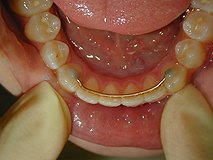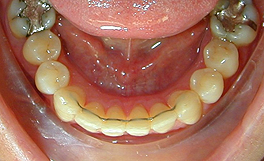Broadly speaking, a retainer is just a brace that is used to stabilise the teeth following orthodontic treatment. The name comes from the verb ‘to retain’ which means to grip. There are both fixed and removable braces. Fixed retainers are usually thin metal wires that are invisible from the outside. They are fixed to the inside of the anterior teeth where they can remain for the whole of a person’s life. The main advantage of the retainer is that it provides reliable stabilisation of the teeth whilst the disadvantages include hygiene complications and occasional problems with the actual adhesive joints.
The retainer with 2 adhesive joints is made of 0.7mm thick, gold-plated steel wire.It’s advantageous because the interdental spaces of the incisors can be cleaned more easily and patients notice immediately when one of the two adhesive joints is detached. However, the incisors are not stabilized as necessary and occasionally twist despite retainer.
The retainer with six adhesive joints is made of 0.4mm thin, braided steel wire. It’s a little more comfortable and reliable than the model with 2 adhesive joints. Though, patients have to put more effort in oral hygiene – nothing is for free.
The common kind of removable retainers in use are plate appliances and transparent plastic strips, occasionally also positioners but the bi-maxillary appliances such as the Activator are less common. From a hygienic point of view, removable braces are of course ideal but they are often unreliable because they are not worn for long enough or they get lost.


